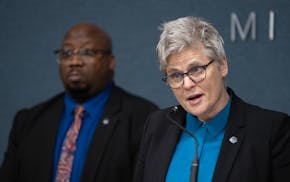Opinion editor's note: Star Tribune Opinion publishes a mix of national and local commentaries online and in print each day. To contribute, click here.
•••
Two smart writers have written thoughtful pieces — one from the right, one from the left — explaining where I've gone terribly wrong.
Both of these pieces are aimed at the same target: what I've called supply-side progressivism or a liberalism that builds. Many of the problems American liberalism is trying to solve today depend on building much more of something and doing so at breakneck speed. Clean energy capacity. Electric vehicle chargers. Homes. Semiconductor factories. Mass transit. Transmission lines. But liberalism is not building at the pace needed to solve any of these challenges. And some of the worst examples of government struggling to build are in the bluest of locales: high-speed rail in California, the Big Dig in Boston, the Second Avenue Subway line in New York, housing in basically every major city you can think of. To solve the problems we face, liberals need to build more and build faster.
Reihan Salam, president of the conservative Manhattan Institute, and David Dayen, executive editor of the liberal American Prospect, think I've erred. Interestingly, their critiques are near-perfect inversions of each other. To Salam, a liberalism that builds might be desirable, but it is politically impossible. To Dayen, building is already plenty easy and making it yet easier would be politically ruinous.
Let's start with Salam. Modern liberalism, he writes, isn't a set of policy ideas meant to achieve discrete ends, but "a political formula, a set of commitments aimed at binding together a diverse Democratic coalition." To him, the main players are "unionized public employees and affluent metropolitan liberals." Unions want the government to employ more labor at higher prices, and metropolitan liberals want low taxes and exclusionary zoning, and these demands are "nonnegotiable."
Salam is offering a classic interest-group analysis of Democratic politics, and there's truth to it. If anything, in confining his concerns to organized labor and educated urbanites, he understates the magnificent array of interests Democrats need to manage. Where do the environmental groups come down? The advocates for the homeless? The CEOs who can no longer stomach the Republican Party and have turned their donations into influence among Democrats?
Where I disagree with Salam is in the way he describes the demands and desires of interest groups and voters as fixed and immovable when, in reality, they are in constant flux. Demands are rarely nonnegotiable. Priorities change not just for reasons of self-interest but because voters and, yes, interest groups come to be convinced of new ideas.
We need not debate this in theory. Policy is changing. Just look around.
Berkeley, Calif., was the first locality to mandate single-family zoning. In 2021, the Berkeley City Council voted to end single-family zoning, as the liberals who call it home came to see that it was a tool of exclusion. California followed suit, passing a bill that functionally outlawed single-family zoning across the entire state. In San Francisco, Mayor London Breed recently proposed reforms to the way housing is built in the city that delighted even the most hardened of YIMBYs. In Los Angeles, voters raised taxes on themselves to address homelessness, and Mayor Karen Bass and the City Council just exempted affordable housing from a lengthy step in the planning process.
Statewide, Gov. Gavin Newsom has now signed more pro-housing bills than I can reasonably describe here, and he just passed a package of permitting and procurement reforms over the initial protests of environmental groups. And it's not just California: Oregon and Maine also outlawed single-family zoning, and Connecticut and Massachusetts have taken steps in the same direction.
That's not to say California's housing crunch will reverse itself quickly — or ever. But policy is changing. And it's changing because voters and interest groups alike are being slowly convinced that more housing, and more building, is necessary for a just or even a decent future.
Salam paints supply-side liberalism as a coterie of "thought leaders without thought followers," but I think this reveals it's the reverse: Residents of blue states are livid at the problems that supply-constrained liberalism has wrought, and politicians and theorists are following that fury to its natural policy conclusions. This is, for blue-state politicians, a matter of both survival and ambition. Newsom, for instance, has clear presidential ambitions, but they are stillborn if he is not seen, by 2028, as the governor who solved California's housing crisis, rather than the one who simply presided over it.
Which brings me to Dayen's critique, which starts in a very different place than Salam's. He begins by noting that the U.S. went from importing liquefied natural gas to being a dominant exporter of it in less than a decade. "What you cannot say is that this industry is the product of a country that has forgotten how to build," he writes. "A mix of national policy, willing financing, and economic and political power easily overcame whatever lethargy is judged to be endemic to the U.S. system."
To Dayen, the rise of natural gas reveals that when an industry has sufficient political might — as the fossil fuel industry does — it can achieve remarkable feats of construction. What's needed, then, is not "a liberalism that builds, but a liberalism that builds power." The way to do that is subsidies and mandates and standards and review processes that cut unions and environmental groups and community organizers in on all this building.
But there are too many differences between natural gas and nationwide decarbonization or housing construction for the analogy to serve the purpose Dayen wants it to serve. Housing, for instance, needs to be built in residential areas. The infrastructure for exporting natural gas largely does not. The politics are radically different.
And there's no reason to search for imprecise comparisons when we can look directly at the industries of interest. Are we building housing fast enough to make it affordable in our most dynamic cities? No. Are we building solar panels and wind farms and transmission lines and battery manufacturing plants and electric vehicle charging stations fast enough to meet our decarbonization goals? No. So then we can ask the question directly: Why not?
When Dayen turns directly to topics like housing, his arguments go awry. He argues that part of the housing crisis is insufficient construction in the aftermath of the Great Recession. True enough. But that doesn't explain why it's functionally impossible to build a six-story apartment building in the most undersupplied neighborhoods of San Francisco and Washington, D.C.
Yes, housing manufacturers misjudged demand 10 years ago. But that is not why they cannot more rapidly increase supply now. Apartment buildings are not technically hard to build. They are politically hard to build.
Dayen's core argument is that what we build reflects who has power — and how it's built changes who has power. What we need, he says, is "the government actively supporting the very groups that have been left out of past economic transitions, building the necessary coalition for long-term transformation." But who exactly is in that coalition? What happens when their interests conflict?
Organized labor is a natural constituency for a liberalism that builds, and its leaders tell me the same in conversations I've had with them. More building really does mean more jobs. In practice, though, the term "organized labor" belies the reality of fractured, disorganized labor organizations at the state and local levels. Housing and environmental bills in California, for instance, often see some unions in opposition and some in support. I've talked in previous columns about the cost and speed gains to be made by using modular housing produced in off-site factories that use union labor. A policy that moved toward that production process is good for the manufacturing unions that staff those factories and tougher for the construction unions that would otherwise have done the on-site building. Who wins that fight?
That said, I think labor is a more natural ally in this project than some other liberal interest groups. You can see that in Pennsylvania, where a section of I-95 collapsed and was rebuilt in a matter of weeks, not months or years, with union labor. So how did it get done?
Gov. Josh Shapiro invoked emergency powers to do away with the normal processes that slow other jobs. The declaration he signed reads, "I hereby suspend the provisions of any other regulatory statute prescribing the procedures for conduct of Commonwealth business, or the orders, rules or regulations of any Commonwealth agency, if strict compliance with the provisions of any statute, order, rules or regulation would in any way prevent, hinder, or delay necessary action in coping with this emergency event."
Shapiro, in this case, chose to use union labor but to gore a lot of other interests and processes. I think Shapiro's choice was the right one. Biden administration officials, who have been quick in conversation to tout their involvement in the I-95 rebuild, also look at the project with pride. But the key point here is that the process Shapiro used is abnormal. In effect, liberals have chosen to trust elected politicians less, and trust regulatory and judicial processes more, to ensure that government delivers what voters want and what justice demands. I think that may have made sense in a past era, but given the problems we face now, it is a mistake. Shapiro's success rebuilding I-95 built political power for him, and it built political power for organized labor — but it could only do that because it put the success of the project first.
This gets to an omission in Dayen's argument. In focusing on how power can be gained, he is ignoring the very real way in which it can be lost. Power is lost when projects fail — and it is lost by the very interest groups Dayen wants to defend.
If union labor and Democratic governance is seen by the public as a reason that needed infrastructure remains endlessly unfinished and relentlessly over budget, that will eventually lead the public to demand alternatives. The result will be the outsourcing of public services to private companies and the election of new politicians who will pass new laws designed to limit the ability of labor to organize.
I'd like to see a stronger labor movement in America, which is one of many reasons I support sectoral bargaining and the mandated appointment of workers to corporate boards. Plenty of countries with stronger unions than the U.S. complete transit projects more rapidly and more affordably than we do. But one of the major challenges of U.S. pro-labor politics is the public perception that unions often slow construction rather than make it better, and that perception is rooted in real failures of real projects in places where liberals and unions hold real power. I don't think that's impossible to fix, but it is impossible to fix if liberals refuse to admit that it is true and refuse to make the policy changes necessary to prove that it's untrue.
Reading Dayen put me in mind of a paper by Michael Gerrard, founder of the Sabin Center for Climate Change Law at Columbia, "A Time for Triage." In it, Gerrard argues that "rather than climate denial, the environmental community has trade-off denial. We don't recognize that it's too late to preserve everything we consider precious, and to linger in making decisions." This is, I would suggest, a broader problem on the left.
There is always the hope of a policy with no losers, or at least no losers we like. But no policy at the scale and speed of decarbonization can fulfill those hopes. In their paper "The Greens' Dilemma," J.B. Ruhl and James Salzman, professors of environmental law at Vanderbilt and UCLA, put this vividly. "Consider that the largest solar facility currently online in the U.S. is capable of generating 585MW," or megawatts, they write. "To meet even a middle-road renewable energy scenario would require bringing online two new 400MW solar power facilities — each taking up at least 2,000 acres — on line every week for the next thirty years." Or take transmission lines. The maximum transition line infrastructure installed in one year was 4,100 miles, in 2010. We're going to need to double that, and do it year after year after year.
I asked Robinson Meyer, executive editor of Heatmap, a news organization tracking the pace of decarbonization, whether we have the capacity to build that infrastructure, at that speed, under the laws and processes we have now. "No, we do not," he said. "We absolutely do not."
And so here is a trade-off that we cannot deny. To decarbonize will require liberals to make a series of choices that radically change the way we build. To refuse to make those choices is to make a different kind of choice. It is to choose the problems of a more rapidly warming world over the problems that will come — and there is no doubt that there will be problems — if we build fast enough to do what we have promised.
Ezra Klein joined New York Times Opinion in 2021. Previously, he was the founder, editor in chief and then editor-at-large of Vox; the host of the podcast "The Ezra Klein Show"; and the author of "Why We're Polarized." Before that, he was a columnist and editor at the Washington Post, where he founded and led the Wonkblog vertical.

BWCA's future likely hinges on election
Saving the dinosaurs: Why there's a future for community newspapers
Readers Write: Gun storage laws, Uber and Lyft, 24/7 businesses, the pipe organ


